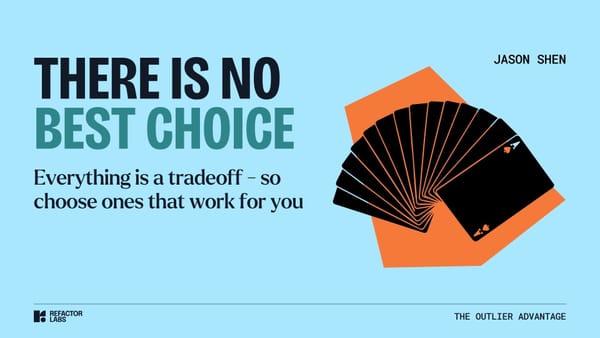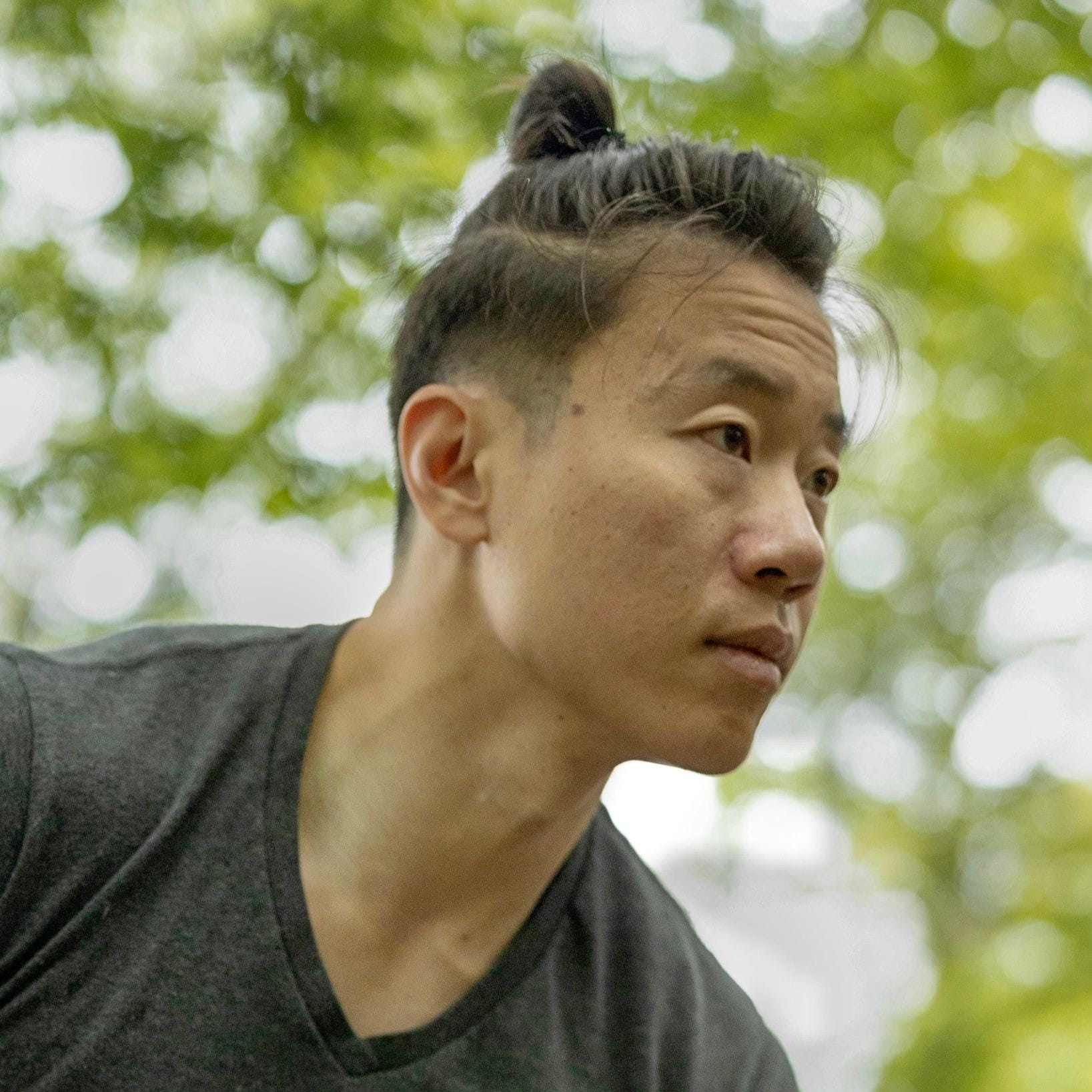A few weeks ago, I was at a wedding catching up with old college friends. We're nearly two decades out of school and you can see the decisions we made in our twenties playing out.
Some married young, gaining a life partner early while giving up a chance to explore themselves alone. Others married later having established their personal identity but lost out on years of companion ship.
Some chose stable careers in medicine and law, gaining steady financial progress in exchange for years of expensive education. Others chose entrepreneurship, preferring the chance of outsized returns while accept the lack of stability and security.
It seemed like everyone was asking themselves if they had taken the right approach. You could feel in the air. Was there a better option I could have chosen?
Here's what I've learned after years of coaching founders through high stakes decisions:
There is no best choice. There are only tradeoffs.
- A director at a consulting firm debating whether to try to make to partner or quit and finally build something of his own
- A founder building a company with healthy revenues wondering whether to pursue profitability or raise a venture round to accelerate growth.
- An engineering manager wondering whether to try and level up a dedicated but underperforming junior eng or let him go and try to hire someone better.
Each of them trying to make the best choice. Each choice containing trade offs: prestige versus possibility, autonomy versus capacity, the devil you know versus the devil you don't.
It's easy to get caught up in a spiral of analysis, debating each option (and there are usually more than two), trying to optimize. And even after you make the choice, its easy to second guess it afterwards if it doesn't pay off immediately or you see someone succeeding with a different approach.
The Perennial Product Review Question
In every product review at Facebook, you could guarantee that at least one senior leader would ask: what tradeoffs are you making here?
If you were smart, you had already made a slide laying it out.
- We're deliberately sacrificing speed for quality
- We're going to take a hit on short-term engagement to increase retention
- We're slowing down project A to make sure project B succeeds
Then the discussion would hinge on whether those were the correct tradeoffs. As a company known for its early mantra of "move fast and break things" - itself a description of choosing speed over stability as a pathway to growth - Facebook understood that no decision was ever perfect. It was better to fully grasp and accept the downsides of any decision in order to embrace its opportunity. Often the final decision came down to which company priority the project could best affect.
At risk of seeming arrogant, I think there's an additional layer to that question that didn't always come up. Another factor that can help break through the gridlock of tough tradeoffs. It requires considering your context, values, constraints, strengths, and goals.
Ben at Stratechery calls this a strategy credit - making choices that make a company look good and succeed in the market without having to struggle with the same complicated tradeoffs as other companies.
You're making a choice that best suits your product, your team, your situation. And by knowing what you care the most about, and what costs you less to lose, you gain clarity about the right decision.
Sam and Deepak
Founders often get stuck because they're searching for a universal playbook.
They see Sam Altman resign as President of Y Combinator to spend years doing pure technology research at OpenAI—no product, no revenue, just hard technical problems. Or they watch some other founder blitz-scale to market dominance through pure execution velocity. And they think: "Which approach is better?"
Neither. Or both. It depends.
Sam once said that he was willing to "take as much time as needed between projects" to his next thing, but it had to be something had the potential to make the rest of his career "look like a footnote." He could tolerate years without customer validation or revenue with OpenAI if it meant pursuing an outcome that'd be bigger than being head of the world's top accelerator.
That tradeoff—immediate traction for long-term capability building—would break most founders psychologically. They need the dopamine hit of customer wins. They need to see the scoreboard changing. That's not weakness. That's just a different cost structure.
Or take Deepak Chugani, CEO of Nuvocargo. After his first startup didn't hit the scale he wanted, he made a call that sounded reckless to most: start over in a completely different industry, building a US-Mexico cross-border logistics business. Most founders after one setback would optimize for safety. Deepak optimized for asymmetric upside, willing to trade another potential failure because he knew—at his age, with his energy level—he wouldn't get another window like this.
But here's the key: he didn't just take a blind risk. His family had import-export experience. He had some Spanish background. The "learn to do business fluently in Mexico" tradeoff was cheaper for him than for a typical founder. His differences changed the equation.
Making tradeoffs work for you
So while tradeoffs exist for every choice, the cost of those tradeoffs differs from person to person. If you're an outlier who maybe processes information deeply instead quickly, who comes from a weird background, who thinks in systems instead of stories, the impact of any given tradeoff is different for you than everyone else.
They change what's expensive for you and what's cheap. What's sustainable and what will grind you down. What creates real advantage versus what just sounds impressive.
Product-led approaches and enterprise software both involve suffering but they have different cost structures. Product-led means rapid feedback cycles, and the ability to tinker until it's right. But you're trading away the clear specifications and security of long-term contracts. Enterprise software gives you those detailed requirements and lucrative deals, but the cost is slow feedback and long sales cycles. The question isn't which is better—it's which set of costs you can absorb without breaking, and which benefits actually compound for how you work.
Likewise, your choice of boss comes with tradeoffs. A notoriously tough boss might offer strategic insight and political air cover, but the cost is constant criticism and emotional volatility.
A supportive boss gives you psychological safety and encouragement, but often you're working on a less exciting area of the company with slower career growth. If you have thick skin, the emotional toll might be negligible while the strategic benefits compound. If you're more sensitive, that same environment could drain you faster than the insights can help you.
Every approach involves suffering. The question is whether you're choosing suffering aligned with your distinct qualities. You can suffer trying to use someone else's playbook - to middling success. Or you can suffer building something only you could build, in a way only you could build it.
Don't Be the Titan Submersible
One important caveat: Don't let "I'm different so I can make different tradeoffs" can turn into "I'm special so the rules don't apply to me." Because sometimes you get the cost benefit analysis wrong. Sometimes the downside even worse than you think.
Remember the Titan submersible? OceanGate CEO Richard Stockton Rush III chose to trade proven titanium hulls for experimental carbon fiber to cut costs and speed up production. They skipped third-party safety certification to avoid delays and scrutiny. They replaced purpose-built, redundant control systems with a $30 PlayStation controller. The tradeoff seemed clear: save money, get to market faster, and unlock a new era of affordable deep-sea tourism.
They paid with their lives.
Being an outlier doesn't mean you can ignore risk. Your differences can change your cost structure for different strategies, but they don't change underlying physics. They don't exempt you from what's actually required for success.
The tradeoff framework helps you choose a path aligned with who you are. It doesn't give you permission to be delusional about risk.
The Cost Structure Question
So here's the shift I want you to make:
Stop asking: "What's the optimal strategy?"
Start asking yourself: What are the key tradeoffs in this decision? And which ones am I uniquely positioned to handle—or will weigh on me less than they would on others?
This requires ruthless honesty about three things:
First, map the actual tradeoffs. Every strategy sacrifices something to gain something else. "Move fast and iterate" trades careful planning for speed and market feedback. "Think deeply before committing" trades rapid experimentation for fewer costly mistakes. Make the exchange explicit: What does this approach give up? What does it get in return?
Second, pinpoint where you gain more than others. Figure out where your unique traits make a strategy asymmetrically powerful.This is where your competitive advantage lives. If you're someone who processes information deeply and sees second-order effects others miss, a "think before committing" strategy lets you spot opportunities competitors will miss entirely. The benefit compounds faster for you. If you have an existing and engaged audience, a content-led strategy will convert at a higher rate because people already trust you.
Third, determine where you pay less than others. Where do the costs of a strategy impact you less while they'd crush someone else? If you're energized by deep research, the "slow and thorough" approach won't feel like a long slog but a fascinating adventure. If you have a low burn rate and patient capital, you can outlast competitors in a strategy that requires long payback periods.
In the Amazon rainforest, certain species of frogs consume a very particular diet of toxic ants, centipedes, and mites to sequester their poison inside their bodies. By hunting and consuming these hard-to-find arthropods, they get to live without fear of snakes, birds, and other predators. They paid the price to earn the prize.
Like the poison dart frog, you can choose tradeoffs that others avoid. If you can handle the downsides they can't, you can build structural advantages for yourself that will push you ahead.
The question is not what's best. The question is: What's best for me?

